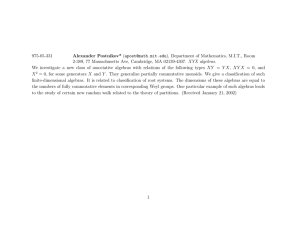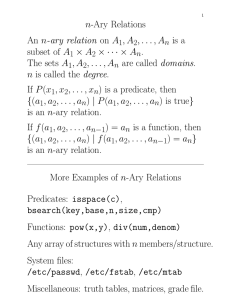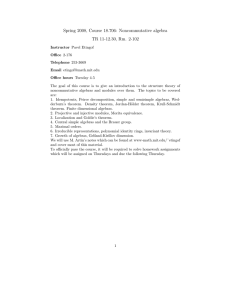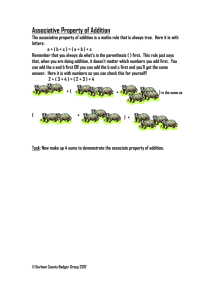n OPERADS FOR -ARY ALGEBRAS – CALCULATIONS AND CONJECTURES
advertisement
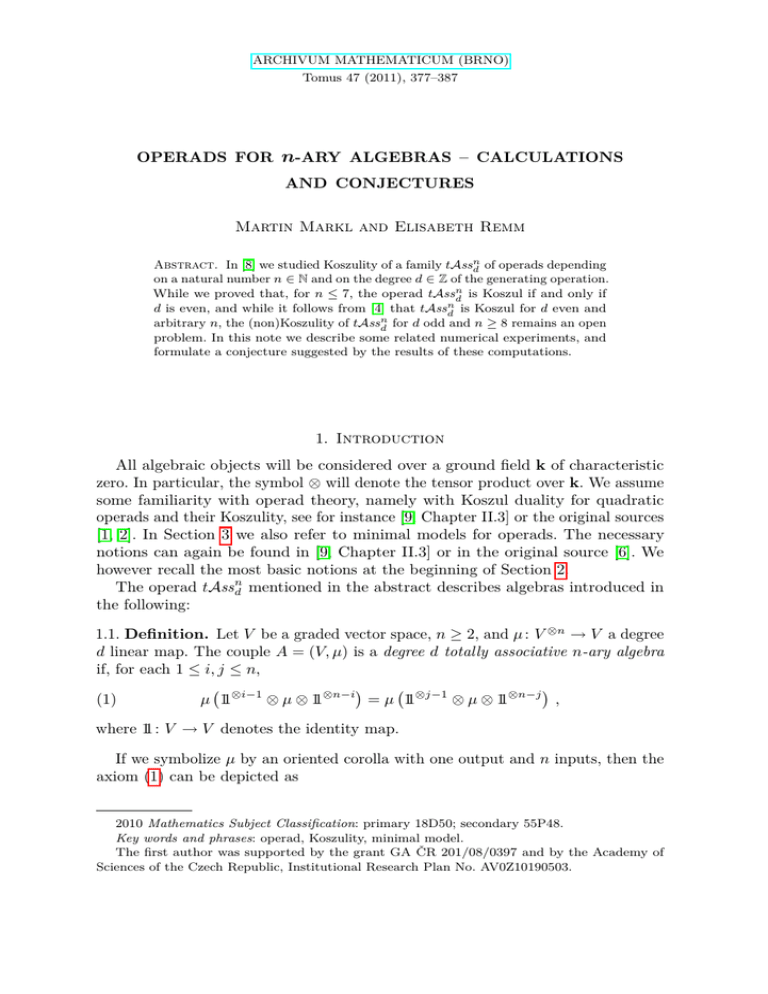
ARCHIVUM MATHEMATICUM (BRNO)
Tomus 47 (2011), 377–387
OPERADS FOR
n-ARY ALGEBRAS – CALCULATIONS
AND CONJECTURES
Martin Markl and Elisabeth Remm
Abstract. In [8] we studied Koszulity of a family tAssn
d of operads depending
on a natural number n ∈ N and on the degree d ∈ Z of the generating operation.
While we proved that, for n ≤ 7, the operad tAssn
d is Koszul if and only if
d is even, and while it follows from [4] that tAssn
d is Koszul for d even and
arbitrary n, the (non)Koszulity of tAssn
d for d odd and n ≥ 8 remains an open
problem. In this note we describe some related numerical experiments, and
formulate a conjecture suggested by the results of these computations.
1. Introduction
All algebraic objects will be considered over a ground field k of characteristic
zero. In particular, the symbol ⊗ will denote the tensor product over k. We assume
some familiarity with operad theory, namely with Koszul duality for quadratic
operads and their Koszulity, see for instance [9, Chapter II.3] or the original sources
[1, 2]. In Section 3 we also refer to minimal models for operads. The necessary
notions can again be found in [9, Chapter II.3] or in the original source [6]. We
however recall the most basic notions at the beginning of Section 2.
The operad tAss nd mentioned in the abstract describes algebras introduced in
the following:
1.1. Definition. Let V be a graded vector space, n ≥ 2, and µ : V ⊗n → V a degree
d linear map. The couple A = (V, µ) is a degree d totally associative n-ary algebra
if, for each 1 ≤ i, j ≤ n,
(1)
µ 11⊗i−1 ⊗ µ ⊗ 11⊗n−i = µ 11⊗j−1 ⊗ µ ⊗ 11⊗n−j ,
where 11 : V → V denotes the identity map.
If we symbolize µ by an oriented corolla with one output and n inputs, then the
axiom (1) can be depicted as
2010 Mathematics Subject Classification: primary 18D50; secondary 55P48.
Key words and phrases: operad, Koszulity, minimal model.
The first author was supported by the grant GA ČR 201/08/0397 and by the Academy of
Sciences of the Czech Republic, Institutional Research Plan No. AV0Z10190503.
378
M. MARKL AND E. REMM
µ
•Q
Q
··· ··· Q
µ ith input
•Q
Q
··· Q
=
µ
•Q
E Q
· · · E · · ·Q ,
E
µ E jth input
•Q
Q
··· Q
with the compositions of the indicated operations taken from the bottom up.
Therefore, in totally associative algebras, all associations of the iterated n-ary
multiplication are the same. Degree 0 totally associative 2-algebras are ordinary
associative algebras. Degree 0 totally associative n-algebras are usually called
simply n-ary totally associative algebras.
Let tAss nd be the operad for degree d totally associative n-algebras. It is not
difficult to prove that the Koszulity of tAss nd depends only on the parity of d. In
this brief note we focus on
Conjecture A. The operad tAss nd is Koszul if and only if d is even.
It follows from the work of Hoffbeck [4] on the Poincaré -Birkhoff-Witt criterion
for operads that tAss nd is Koszul for d even. In [8] we proved that tAss nd is not
Koszul if d is odd and n ≤ 7. The non-Koszulity for d odd and n ≥ 8 is therefore
still conjectural.
2. Ginzburg-Kapranov’s criterion for n-ary operads
For convenience of the reader we recall, following [8], some features of the Koszul
duality of non-binary operads. Assume E = {E(a)}a≥2 is a Σ-module of finite type
concentrated in arity n. Operads P = Γ(E)/(R), where Γ(E) is the free operad on
E and (R) the ideal generated by a subspace R ⊂ Γ(E)(2n − 1) are called n-ary
quadratic. Let E ∨ = {E ∨ (a)}a≥2 be the Σ-module with
sgna ⊗ ↑a−2 E(a)# , if a = n and
E ∨ (a) :=
0,
otherwise
where ↑a−2 is the iterated suspension, sgna the signum representation, and # the
linear dual of a graded vector space with the induced representation. There is a
non-degenerate pairing
h−|−i : Γ(E ∨ )(2n − 1) ⊗ Γ(E)(2n − 1) → k .
Its concrete form is not relevant for this note, the details can be found in [9,
page 142].
2.1. Definition. The Koszul dual of the n-ary operad P = Γ(E)/(R) is the quotient
P ! := Γ(E ∨ )/(R⊥ ) ,
where R⊥ ⊂ Γ(E ∨ )(2n − 1) is the annihilator of R ⊂ Γ(E)(2n − 1) in the above
pairing, and (R⊥ ) the ideal generated by R⊥ .
n-ARY ALGEBRAS – CALCULATIONS AND CONJECTURES
379
If P is n-ary, generated by an operation of degree d, then the generator of P !
has the same arity but degree −d + n − 2, i.e. for n =
6 2 (the non-binary case)
the Koszul duality may not preserve the degree of the generating operation. In
the following standard definition, D(−) denotes the dual operad construction [2,
(3.2.12)]. Recall that it is essentially the bar construction (which takes operads to
cooperads) followed by the componentwise vector space dual (which takes cooperads
to operads). In Section II.3.3 of the monograph [9], D(−) was called the dual bar
construction.
2.2. Definition. A quadratic operad P is Koszul if the natural map D(P ! ) → P is
a homology equivalence.
The definition below describes algebras over the Koszul dual of tAss nd .
2.3. Definition. Let V be a graded vector space and µ : V ⊗n → V a degree d
linear map. The couple A = (V, µ) is a degree d partially associative n-ary algebra
if the following single axiom is satisfied:
n
X
(−1)(i+1)(n−1) µ 11⊗i−1 ⊗ µ ⊗ 11⊗n−i = 0 .
i=1
In partially associative n-ary algebras, all associations of the multiplication (with
alternating signs if n is even) sum to zero. So, for n = 2 one has
((ab)c) − (a(bc)) = 0 ,
thus degree d partially associative 2-ary algebras are associative algebras with
multiplication of degree d. For n = 3 one has
((abc)de) + (a(bcd)e) + (ab(cde)) = 0 .
Degree (n − 2) partially associative n-ary algebras are precisely A∞ -algebras
A = (V, µ1 , µ2 , . . .) [5, §1.4] which are meager in that they satisfy µk = 0 for k =
6 n.
Their symmetrizations are Lie n-algebras [3].
Let pAss nd denote the operad for degree d partially associative n-ary algebras.
The following statement follows from a simple calculation.
2.4. Proposition. One has isomorphisms of operads
∼ pAss n
(tAss n )! =
,
−d+n−2
d
∼ tAss n
(pAss nd )! =
−d+n−2 .
Observe the shift of the degree of the generating operation. Since P is Koszul if
and only if P ! is, one may reformulate the conjecture as
Conjecture A’. The operad pAss nd is Koszul if and only if n ≡ d mod 2.
Recall that the generating or Poincaré series of an operad P = {P(a)}a≥1 in
the category of graded vector spaces of finite type is defined by
X 1
gP (t) :=
χ(P(a))ta ,
a!
a≥1
where χ(−) denotes the Euler characteristic.
380
M. MARKL AND E. REMM
2.5. Example. It is not difficult to verify that the generating series for the operad
tAss nd is
t + tn + t2n−1 + t3n−2 + t4n−3 + · · · , if d is even,
gtAss n (t) :=
d
t − tn + t2n−1 ,
if d is odd.
We see that, for d odd, tAss nd is nontrivial only in arities 1, n and 2n − 1. This
is best explained by taking the simplest case n = 2 and analyzing the operadic
g := s −1 tAss 2 .
desuspension Ass
1
Recall that the operadic desuspension s −1 P of an operad P = {P(a)}a≥1 is the
operad s −1 P = {s −1 P(a)}a≥1 , where s −1 P(a) := sgna ⊗↓a−1 P(a), the signum
representation tensored with the (ordinary) desuspension of the graded vector space
P(a) iterated (a − 1) times. The structure operations of s −1 P are induced by those
of P in the obvious way. The Poincaré series of the operad P and its suspension
s −1 P are clearly related by
(2)
gs −1 P (t) = −gP (−t) .
g turn out to be anti-associative algebras with a
Algebras for the operad Ass
degree 0 multiplication satisfying
a(bc) = −(ab)c ,
for a, b, c ∈ V .
g
g
g
g
While Ass(1)
= k, Ass(2)
= k[Σ2 ] and Ass(3)
= k[Σ3 ], the vanishing Ass(4)
=0
follows from the ‘fake pentagon’
−(ab)(cd)
(((ab)c)d)
Q
Q
QQ
Q
Q
(a(b(cd)))
−(a(b(cd)))
JJ
JJ
JJ
JJ
−((a(bc))d)
(a((bc)d))
by which all 4-fold products are trivial, as well as all a-fold products for a ≥ 4.
g
g is therefore
In other words, Ass(a)
= 0 for a ≥ 4, so the generating series for Ass
2
2
3
t + t + t . By (2), the generating series of tAss 1 equals
t − t2 + t3
as claimed.
We finally formulate the (generalized) Ginzburg-Kapranov test [2]:
2.6. Theorem. If a quadratic, not necessary binary, operad P is Koszul, then its
Poincaré series and the Poincaré series of its dual P ! are tied by the functional
equation
gP (−gP ! (−t)) = t .
n-ARY ALGEBRAS – CALCULATIONS AND CONJECTURES
381
In other words, −gP ! (−t) is a formal inverse of gP (t).
The following particular form of the GK-test is a simple consequence of the
above facts.
2.7. Proposition. If the operad tAss nd is Koszul, then all coefficients in the formal
inverse of t − tn + t2n−1 are non-negative.
The following theorem proved in [8] follows from the theory of analytic functions.
2.8. Theorem. Suppose g(z) is an analytic function in C such that g(0) = 0 and
g 0 (0) = 1. If the equation
g 0 (z) = 0
has no real solutions, then the formal inverse g −1 (z) has at least one negative
coefficient.
For the generating function g(z) := z − z n + z 2n−1 of tAss nd , the equation
g (z) = 0 reads
g 0 (z) = 1 − nz n−1 + (2n − 1)z 2n−2 = 0
which, after the substitution w := z n−1 , leads to
0
1 − nw + (2n − 1)w2 = 0 .
(3)
Fact. The discriminant n2 − 8n + 4 of (3) is negative for n ≤ 7 and positive for
n ≥ 8.
The Fact explains the distinguished rôle of n = 7 resp. 8. By Theorem 2.8, the
inverse of t − tn + t2n−1 has, for n ≤ 7, a negative coefficient so tAss nd is for d odd
and n ≤ 7 not Koszul.
7p
7p
Equation (3) has, for n = 8, two real solutions, z1 =
1/3 and z2 =
1/5.
Therefore, for n = 8 as well as for all higher n’s, Theorem 2.8 does not apply
and we are unable to prove the existence of negative coefficients in the inverse of
z − z n + z 2n−1 . On the contrary, the calculations given in Section 3 indicate that
all coefficients of the inverse are positive, so the Ginzburg-Kapranov criterion is
not determinative.
3. Calculations, gaps and another conjecture
We computed, using Mathematica, the initial parts of the formal inverse of
t − tn + t2n−1 for n ≤ 8. We found:
t + t2 + t3 − 4t5 − 14t6 − 30t7 − 33t8 + 55t9 + · · ·
for n = 2,
t + t3 + 2t5 + 4t7 + 5t9 − 13t11 − 147t13 + · · ·
for n = 3, and
t + t4 + 3t7 + 11t10 + 42t13 + 153t16 + 469t19 + 690t22 − 5967t25 + · · ·
for n = 4.
382
M. MARKL AND E. REMM
The first negative coefficient in the inverse of t − tn + t2n−1 was at t57 for n = 5,
at t161 for n = 6, and at t1171 for n = 7. For n = 8 we did not find any negative
term of degree less than 10 000.
To appreciate the growth of the first negative coefficient, we introduce hpi :=
p(n − 1) + 1, p ≥ 0, the arity of an operation composed of p instances of an n-ary
multiplication. The following table shows n and the corresponding p such that the
first negative coefficient occurs at thpi :
n=
2
3
4
5
p=
4
5
8
14 32 195
6
7
8
∞?
The dependence of p on n is plotted in the following table that clearly indicates
that p = ∞ for n ≥ 8, i.e. that there are no negative coefficients in the inverse of
t − tn + t2n−1 :
6
8–
7–
6–
5–
•
•
•
4– •
3–•
2 –•
n = 1–
–
p=
50
100
150
Although the GK-test does not apply for n ≥ 8, there are some other indications
that the operad tAss nd , d even, may not be Koszul.
3.1. Example. In [8] we explicitly established the initial part of the minimal model
of pAss 21 = (tAss 2−1 )! ,
(4)
(pAss 21 , 0) ← (Γ(E2 , E3 ,
, E5 , . . .), ∂) .
Here E2 is an one-dimensional space placed in arity 2, E3 is one-dimensional placed
in arity 3, and E5 is 4-dimensional in arity 5.
It was the first non-trivial calculation of part of the minimal model of a
non-Koszul operad. As shown in [8], the restriction ∂|E5 is not quadratic but
ternary. It then follows from the construction of [7] that the L∞ -deformation
complex for pAss 21 -algebras has a non-trivial l3 -term.
The gap
in arity 4 generators is caused by the ‘wrong’ signs in the pentagon,
see Example 2.5. The fact that it is followed by a nontrivial space E5 shows that
n-ARY ALGEBRAS – CALCULATIONS AND CONJECTURES
383
pAss 21 is not Koszul, as follows from a proposition below which we formulate for
the n-ary case, for arbitrary n ≥ 2.
Recall hpi := p(n − 1) + 1, p ≥ 0. If P is n-ary, then P(n) 6= 0 only for n = hpi
for some p ≥ 0, and for the generators E of the minimal model (P, 0) ← (Γ(E), ∂)
clearly the same holds:
E(n) 6= 0 only for n of the form n = hpi for some p ≥ 0.
3.2. Definition. The minimal model of an n-ary operad has a gap of length d ≥ 1
if there is q ≥ 2 such that
E(hpi) = 0 for q ≤ p ≤ q + d − 1
while
E(hq − 1i) 6= 0 6= E(hq + di) .
The model of pAss 21 is of the form (Γ(Eh1i , Eh2i , , Eh4i , . . .), ∂) with non-trivial
Eh2i and Eh4i . So it has a gap of length 1 – with d = 1, q = 3 in the above definition.
3.3. Proposition. Suppose that the minimal model of a quadratic n-ary operad P
has a gap of finite length. Then P is not Koszul.
Proof. Suppose that P is Koszul and let (P, 0) ← (Γ(E), ∂) be its minimal model.
It follows from Definition 2.2 and the uniqueness of the minimal model for operads
[9, Theorem II.3.126] that the collection E is the (suitably suspended) Koszul dual
P ! . The operad P ! is n-ary, too, so P ! (hqi) = 0 for some q ≥ 2 implies P ! (hpi) = 0
for all p ≥ q. Thus P ! and therefore also E cannot have a gap of a finite length. The strategy we suggest is to study the gaps in the minimal model of pAss nd with
n 6≡ d mod 2. Their existence would imply non-Koszulity of pAss nd , as well as the
non-Koszulity of their Koszul duals tAss nd , d odd, thus establishing Conjecture A.
It is not difficult to prove the following:
3.4. Proposition. Let P be an arbitrary, not necessarily Koszul, operad with
P(1) = k, and (P, 0) ← (Γ(E), ∂) its minimal model. The Poincaré series gP (t) of
P is related with the generating function
X 1
χ(E(a))ta
gE (t) := −t +
a!
a≥2
of the Σ-module {E(a)}a≥2 by the functional equation
gP (−gE (t)) = t .
The above theorem enables one to calculate the Poincaré series of the collection
of generators of the minimal model of P from the generating series of P. It clearly
implies the GK-criterion.
3.5. Example. It happens that pAss 21 = tAss 21 , so the generating series of pAss 21 is
gpAss 2 (t) = t − t2 + t3 .
1
384
M. MARKL AND E. REMM
One can compute the formal inverse of this function as
t + t2 + t3 − 4t5 − 14t6 − 30t7 − 33t8 + 55t9 + · · · .
The absence of the t4 -term together with the presence of the t5 -term “shows” the
gap of length 1 in the minimal model of pAss 21 .
We do not know any closed formula for the generating series of pAss nd with
n 6≡ d mod 2, n > 2. We however wrote a script for Mathematica that calculates it,
but its applicability is drastically limited by computers available. We established
the generating series for pAss 30 as
t + t3 + 2t5 + 4t7 + 5t9 + 6t11 + 7t13 + 8t15 + · · · ,
the generating series of pAss 41 as
t − t4 + 3t7 − 11t10 + 42t13 − 153t16 + 565t19 + · · · ,
the generating series of pAss 50 as
t + t5 + 4t9 + 21t13 + 123t17 + 759t21 + · · · ,
the generating series of pAss 70 as
t + t7 + 6t13 + 50t19 + 481t25 + · · ·
and the generating series of pAss 90 as
t + t9 + 8t17 + 91t25 + 1207t33 + · · · .
By calculating the formal inverses of the above series, we get the following Poincaré
series of the generators for the minimal models:
t + t2 + t3 + 0 t4 − 4t5 − 14t6 − 30t7 − 33t8 + 55t9 + · · ·
for pAss 21 (we already know this),
t − t3 + t5 + 0 t7 + 0 t9 − 19 t11 + 112 t13 − 336 t15 + · · ·
for pAss 30 ,
t + t4 + t7 + 0 t10 + 0 t13 + 0 t16 − 96 t19 + · · ·
for pAss 41 ,
t − t5 + t9 + 0 t13 + 0 t17 + 0 t21 + ? + O[t25 ]
for pAss 50 . The vanishing of the boxed terms imply, by Proposition 3.4, that the
Euler characteristics of the corresponding pieces of the generating collection is zero.
n-ARY ALGEBRAS – CALCULATIONS AND CONJECTURES
385
It indicates that the minimal models are of the form
(pAss 21 , 0) ← (Γ(Eh1i , Eh2i ,
, Eh4i , . . .), ∂),
(pAss 30 , 0) ← (Γ(Eh1i , Eh2i ,
,
, Eh5i , . . .), ∂),
(pAss 41 , 0) ← (Γ(Eh1i , Eh2i ,
,
,
, Eh6i , . . .), ∂),
(pAss 50 , 0) ← (Γ(Eh1i , Eh2i ,
,
,
, ? , ? , . . .), ∂).
Our computation did not go beyond n ≥ 6, due to limitations of computer memory.
The results for small n’s however suggest that the gap grows linearly with n,
leading to
Conjecture B. The minimal model of pAss nd , n 6≡ d mod 2, has a gap of length
n − 1.
The conjecture would obviously imply the non-Koszulity of tAss nd , for d odd.
If it is so, then tAss 81 will be the first example of a non-Koszul operad whose
non-Koszulity was not established by the Ginzburg-Kapranov criterion.
3.6. Remark. We followed a suggestion of the referee and compared the sequences
arising in this section with The Online Encyclopedia of Integer Sequences. It
recognized the generating series for pAss 21 . This was not surprising as we know
a closed formula. It also identified the initial part of the generating series for pAss 30
to a subsequence of the sequence {us }s≥1 , where us is the number of times 1 is
used in writing out all the numbers 1 through s. We do not have any explanation
for this fact. The remaining sequences were not recognized.
3.7. Remark. Degree 0 totally associative n-algebras, i.e. algebras over the operad
tAss n0 , generalize, for n ≥ 3, associative algebras in a straightforward manner. The
referee formulated an intriguing question whether there exists an analog of the
associahedra for these algebras. In this remark we argue that this might indeed be
possible.
Recall that Stasheff’s operad of associahedra K = {Ka }a≥1 is an operad in the
category of polyhedra. Its most important property is that its operad of cellular
chains is isomorphic to the minimal model of the associative operad [6, Example 4.8].
Let us try to start constructing the ‘ternary’ associahedron K3 = {Ka3 }a≥1 for
totally associative 3-algebras, mimicking the construction of the classical Stasheff
operad. It is clear that the first nontrivial piece of K3 is the point K33 in arity 3
that represents the ternary multiplication.
The next piece K53 of the 3-associahedron must have three vertices corresponding
to the three possible bracketing of five variables, namely
v1 := ((•, •, •), •, •), v2 := (•, (•, •, •), •), and v3 := (•, •, (•, •, •)).
386
M. MARKL AND E. REMM
For the edges of K53 we need to choose two of the three relations killing the
differences v1 − v2 , v2 − v3 and v1 − v3 , because the resulting K53 must be acyclic.
If we chose e.g. the first two ones, we get the following picture of K53 :
((•, •, •), •, •)
(•, (•, •, •), •)
(•, •, (•, •, •))
•
•
•
3
So K5 is the interval divided into two subintervals. Having K33 and K53 as above,
the 1 skeleton of K73 is the graph:
•
S
• S
• S
S
• H
•H S
•
HHS
S
H
•
•
•
H
HH •
H
H•H
•
Now we have to choose five cycles, out of six, of this 1-skeleton and fill them
by 2-dimensional faces. Since the figure above has an obvious left-right mirror
symmetry, there are precisely three essentially independent choices. Depending on
the choice, we get the following three combinatorially distinct K73 ’s:
•XX •
•
XXX
C
•
C
•C
@• •
•
•
•
C • @•
@
•
@
@
•C
@•
@•
•
•
•
They are convex polyhedra with twelve vertices, sixteen edges and five 2-dimensional
faces.
Each choice of K33 , K53 and K73 determines the 2-skeleton of K93 . To perform
the next step, we need to kill the generators of the second homotopy group of this
2-skeleton by choosing fourteen 3-dimensional faces, etc.
The fundamental difference from the construction of the classical associahedron
is that at each step we need to make a choice, and that the combinatorial type of
the resulting polyhedra depends on these choices. We formulate the last conjecture
of this note:
•
@
•
•
@
•
•
•
•
@
•• •
@
•
@•
•
•
•
•
•
Conjecture C. For each n ≥ 3, there exists an operad Kn in the category of
contractible polyhedra such that the minimal model of the operad for degree 0
n-ary totally associative algebras is isomorphic to the cellular chain operad of Kn .
Acknowledgement. The authors are indebted to the referee for careful reading
the manuscript and several useful comments and suggestions.
n-ARY ALGEBRAS – CALCULATIONS AND CONJECTURES
387
References
[1] Getzler, E., Jones, J. D. S., Operads, homotopy algebra, and iterated integrals for double loop
spaces, Preprint hep-th/9403055, March 1994.
[2] Ginzburg, V., Kapranov, M. M., Koszul duality for operads, Duke Math. J. 76 (1) (1994),
203–272.
[3] Hanlon, P., Wachs, M. L., On Lie k-algebras, Adv. Math. 113 (1995), 206–236.
[4] Hoffbeck, E., A Poincaré–Birkhoff–Witt criterion for Koszul operads, Manuscripta Math. 131
(1–2) (2010), 87–110.
[5] Markl, M., A cohomology theory for A(m)-algebras and applications, J. Pure Appl. Algebra
83 (1992), 141–175.
[6] Markl, M., Models for operads, Comm. Algebra 24 (4) (1996), 1471–1500.
[7] Markl, M., Intrinsic brackets and the L∞ -deformation theory of bialgebras, J. Homotopy
Relat. Struct. 5 (1) (2010), 177–212.
[8] Markl, M., Remm, E., (Non–)Koszulness of operads for n-ary algebras, galgalim and other
curiosities, Preprint arXiv:0907.1505.
[9] Markl, M., Shnider, S., Stasheff, J. D., Operads in Algebra, Topology and Physics, Math.
Surveys Monogr., vol. 96, Amer. Math. Soc., Providence, RI, 2002.
Mathematical Institute of the Academy,
Žitná 25, 115 67 Prague 1, The Czech Republic
E-mail: markl@math.cas.cz
Laboratoire de Mathématiques et Applications,
Université de Haute Alsace, Faculté des Sciences et Techniques,
4, rue des Frères Lumière, 68093 Mulhouse cedex, France
E-mail: Elisabeth.Remm@uha.fr
